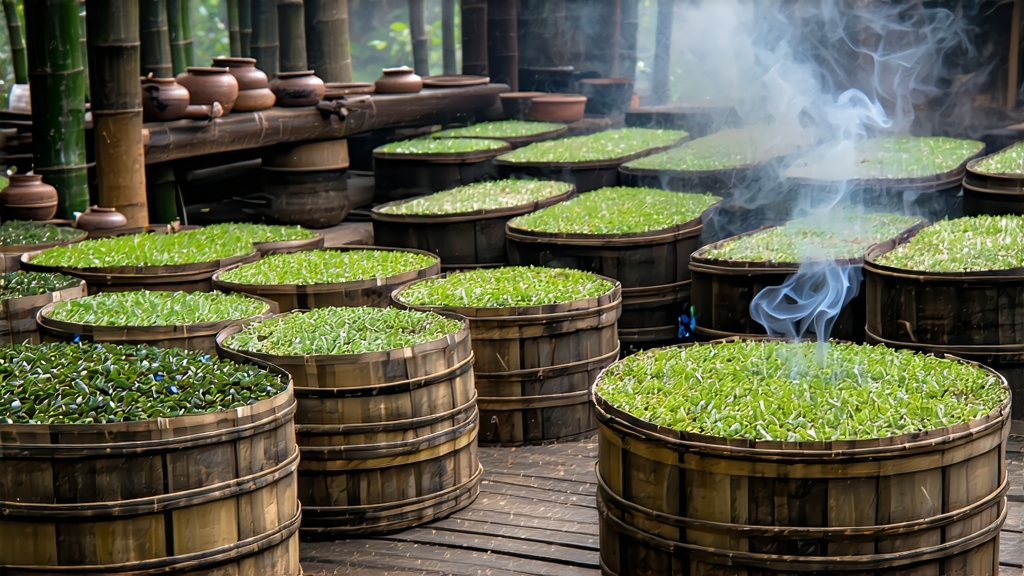
Ask most tea lovers to name the first black tea ever created and they will pause; mention Lapsang Souchong, however, and eyes light up with the image of a dark, glossy leaf and an unmistakable campfire aroma. This small-leaf cultivar from the Wuyi massif in China’s north-west Fujian province is not merely another black tea—it is the prototype that launched the entire category in the early seventeenth century. What follows is a journey through its storied past, its two stylistic faces, the meticulous craft that marries wood and leaf, and the quiet discipline required to coax its full spectrum of flavor into a cup.
-
A history written in pine smoke and maritime trade
Local legend dates the birth of Lapsang Souchong to 1646, when Qing army units passing through Xingcun town forced tea farmers to speed up drying. In desperation the villagers lit open fires of fresh pine, inadvertently bathing the leaves in resinous smoke. The Dutch traders who received the cargo in Java adored the novel taste and clamoured for more; by 1669 the British East India Company had listed “Bohea Souchong” at London auctions, pricing it above every other China tea. The name itself encodes geography: “Lapsang” is the Fuzhou-dialect rendering of Lapu mountain village, while “Souchong” refers to the fourth or fifth leaf down the stem—older, tougher material once considered inferior until smoke transfigured it into gold. For two centuries the tea travelled the clipper route through Jakarta, Amsterdam and Boston, financing porcelain caravans back to Wuyi and inspiring the Assam and Ceylon plantations that tried, unsuccessfully, to imitate its flavor. -
Two siblings: smoked versus unsmoked
International markets still associate Lapsang Souchong with bold smoke, yet within Fujian connoisseurs prize a subtler, unsmoked “Zheng Shan Xiao Zhong” that showcases the natural fruit and malt of the Wuyi microclimate. Smoked versions use the same cultivar—typically a small-leaf Camellia sinensis var. sinensis known locally as “cai cha”—but diverge after fermentation. Unsmoked leaf is baked over hot charcoal made from local hardwood, yielding a liquor of dried longan, honey and mild rock-mineral notes. Smoked leaf, by contrast, is spread on bamboo trays suspended in the upper storey of a three-tier pine room; below, pine logs smoulder at 60–70 °C for six to eight hours, repeated up to three times. The resin penetrates the leaf surface, bonding with theaflavins and forming the characteristic guaiacol and syringol compounds that perfumers liken to single-malt whisky and smoked paprika. -
Craft: from withering to pine-fired finish
Plucking begins in late April, when buds have opened into one leaf and a half. The cool gorge climate slows growth, concentrating amino acids. Leaves are laid 3 cm deep on bamboo mats in open-walled upper rooms where mountain breezes reduce moisture to 60 % within eight hours. Rolling follows the traditional “pine board knead”: 5 kg batches are wrapped in cloth and trodden by barefoot artisans who rotate the bundle every minute, bruising cells without shredding the leaf. Oxidation proceeds in wooden troughs lined with wet cotton; the Wuyi night air, heavy with fog and 85 % humidity, turns the leaf a coppery mahogany in roughly three hours. The critical divide occurs next. For unsmoked tea the leaf is charcoal-baked at 90 °C, pans turned every thirty seconds until a “sand-sound” rustles inside. For smoked tea the leaf ascends to the loft where fresh pinus massoniana and pinus taiwanensis logs—never resin-soaked—release a steady blue smoke. Master smokers judge readiness by aroma alone: too short and the scent is harsh, too long and it turns kerosene-like. A final 100 °C bake fixes the fragrance, after which the tea rests one month so smoke and leaf can marry. -
Grading: tong, zheng, and the elusive “cigar leaf”
European importers once used a cryptic code: TGFOP (Tippy Golden Flowery Orange Pekoe) meant little in Wuyi. Local